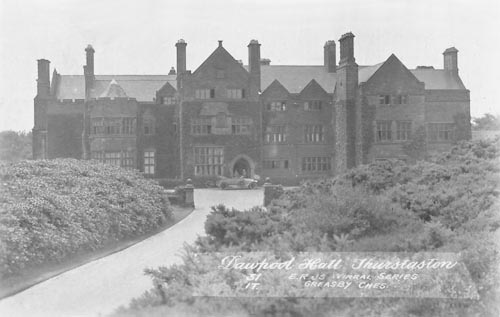Dawpool
Cheshire
| Location | Thurstaton | ||
| Year demolished | 1927 | ||
| Reason | Surplus | ||
| See all images: | Gallery | ||
| << Back to the main list |
Some houses last for hundreds of years before finally vanishing whilst others can be built and vanish in a few decades. Dawpool was one man's pleasure and his passing also signalled the beginning of the end of the house - its demolition coming a mere 43 years after it was built.
Acquisition of the estate and commissioning of Shaw
 In 1877, Thomas Henry Ismay (1837–1899), founder of the Oceanic Steam Navigation Company - better known as the White Star Line - purchased the Dawpool estate in Thurstaston on the Wirral Peninsula, then part of Cheshire. At the time of acquisition, the estate extended to approximately 390 acres and included a house built in 1865, which Ismay promptly demolished. His intention was not to build a working estate centre, but rather a private seat reflecting his commercial success and aspirations to enter the landed gentry.
In 1877, Thomas Henry Ismay (1837–1899), founder of the Oceanic Steam Navigation Company - better known as the White Star Line - purchased the Dawpool estate in Thurstaston on the Wirral Peninsula, then part of Cheshire. At the time of acquisition, the estate extended to approximately 390 acres and included a house built in 1865, which Ismay promptly demolished. His intention was not to build a working estate centre, but rather a private seat reflecting his commercial success and aspirations to enter the landed gentry.
To design his new house, Ismay appointed Richard Norman Shaw RA (1831–1912), one of the leading architects of the Victorian era, known for his development of the Queen Anne Revival and the so-called "Old English" domestic style. Shaw’s previous commissions included Cragside for Lord Armstrong and Adcote in Shropshire - houses that similarly conveyed modern industrial wealth through picturesque, vernacular architecture.
Construction and architectural features
The foundation stone for Dawpool was laid in 1882 and the house took four years to complete. It was constructed in a robust Domestic Revival style using local red sandstone, executed with the highest standards of Victorian craftsmanship. The house featured steep gables, mullioned windows, ornamental chimneys, and extensive use of bespoke joinery and ironmongery. Only the finest materials were employed, including specially cast brass fittings, and the workmanship was of a standard rarely matched outside the highest aristocratic commissions.
The total reported cost of construction was £50,000, a considerable sum in the 1880s. In modern terms, this equates to £13–18 million, depending on the method of calculation (average earnings or labour value). This places Dawpool above the scale of modest gentleman’s residences, and into the upper-middle tier of Victorian country house building - less lavish than Waddesdon Manor or Cragside, but significantly grander than many contemporary new builds.
In addition to the main house, a stable block and lodge were also constructed in complementary style and to the same exacting standards. Country Life later described Dawpool as “a fine and acknowledged masterpiece” of Norman Shaw's later domestic work.
A house better than the setting
Although the architectural design and construction were executed to an exemplary standard, less consideration appears to have been given to the setting and landscape composition. Dawpool occupied a hollow midway up a gently rising hill, facing westward toward the Dee Estuary and the Welsh hills. While the panoramic views were undoubtedly striking, the house lacked the conventional landscape elements of a major seat—there was no designed parkland, ornamental flower gardens, or formal avenues. Few mature trees screened the site, and the exposed location limited successful planting to more resilient but visually unremarkable species. The 390-acre estate, though not insubstantial, was modest by the standards of traditional landed estates.
This relative deficiency of surrounding landscape ornament may have contributed to a perception of imbalance - an architecturally ambitious house without a setting to match its scale and formality.
Occupation and early decline
Ismay occupied the completed Dawpool for just over a decade before his death in 1899. Neither his widow nor his son, Joseph Bruce Ismay (1862–1937), expressed strong attachment to the house. As early as 1897, Mrs Ismay is recorded as having told Shaw that the house had served its purpose in keeping her husband "amused for fifteen years."
Following Thomas Ismay’s death, the family vacated Dawpool in 1907. The property was subsequently sold to Sir Herbert Roberts, 1st Baronet (later Baron Clwyd), and then passed to Mr F.W.P. Rutter, likely before the First World War. Rutter permitted the use of the house as an auxiliary military hospital for officers during the latter stages of the war. This repurposing marked the beginning of Dawpool’s functional decline.
In 1919, 28 acres of the estate were sold. The house, while still structurally sound and architecturally distinguished, began a period of neglect and underuse. The final recorded social function was a garden party held in September 1926 in aid of the local cottage hospital.
Demolition and surviving elements
In 1927, Dawpool was sold for demolition. A sale of interior fittings preceded its destruction. Owing to the quality and solidity of the construction, explosives were required to bring down the structure — an uncommon measure that underscored the building’s exceptional craftsmanship.
Some architectural elements were salvaged. Most notably, one of the large carved fireplaces was removed and later installed in The Pantheon at Portmeirion, the Italianate village designed by Sir Clough Williams-Ellis in North Wales.
A smaller modern residence was later erected on or near the footprint of the original house. This new building is said to incorporate portions of Dawpool’s extensive cellars, though no above-ground structures survive.